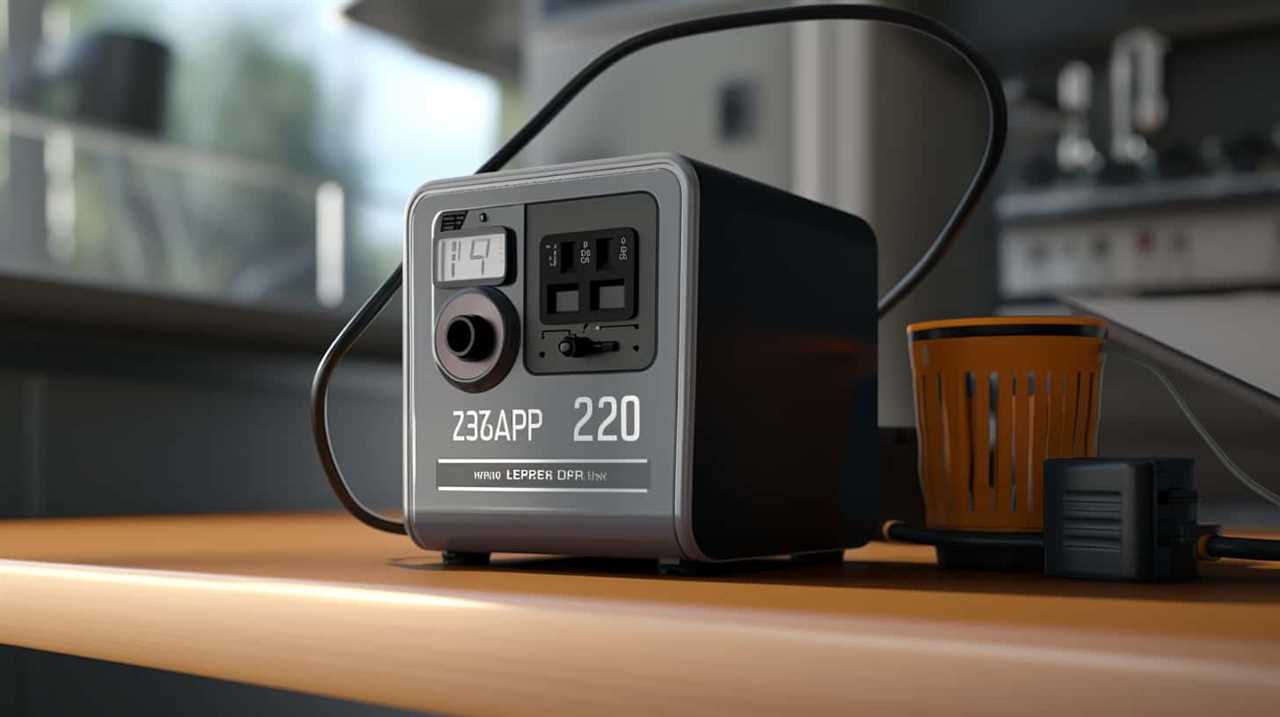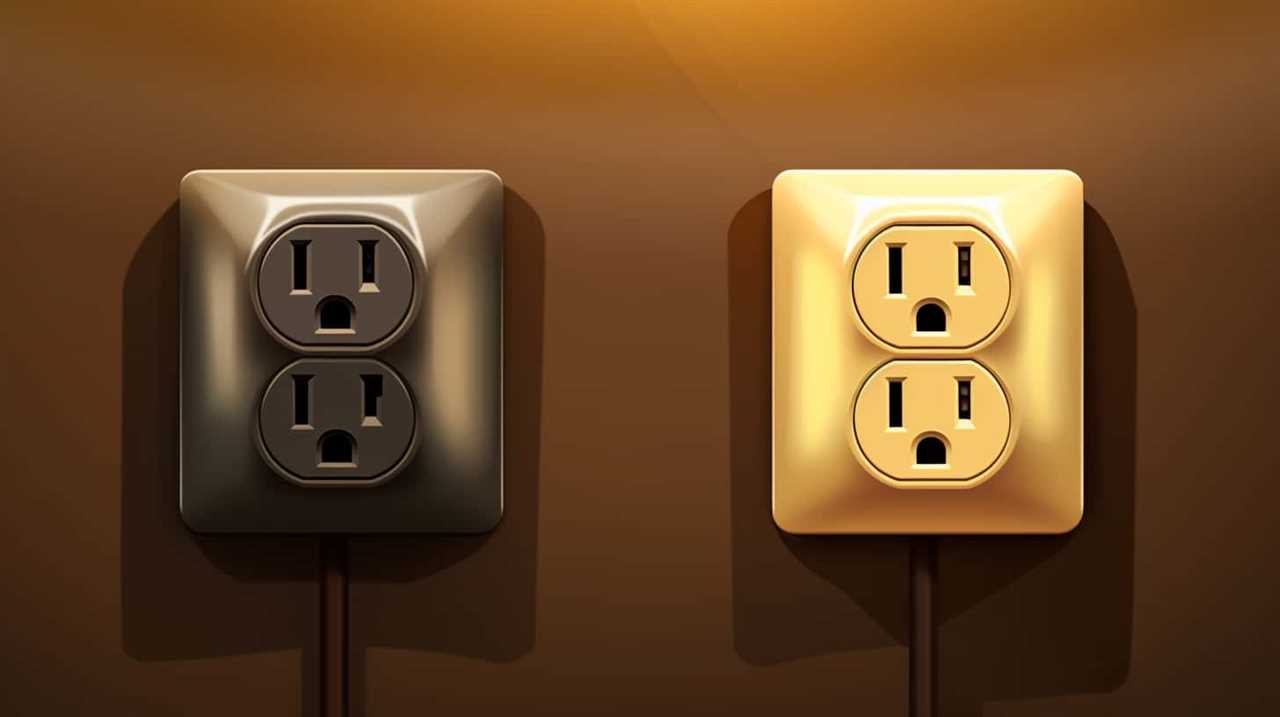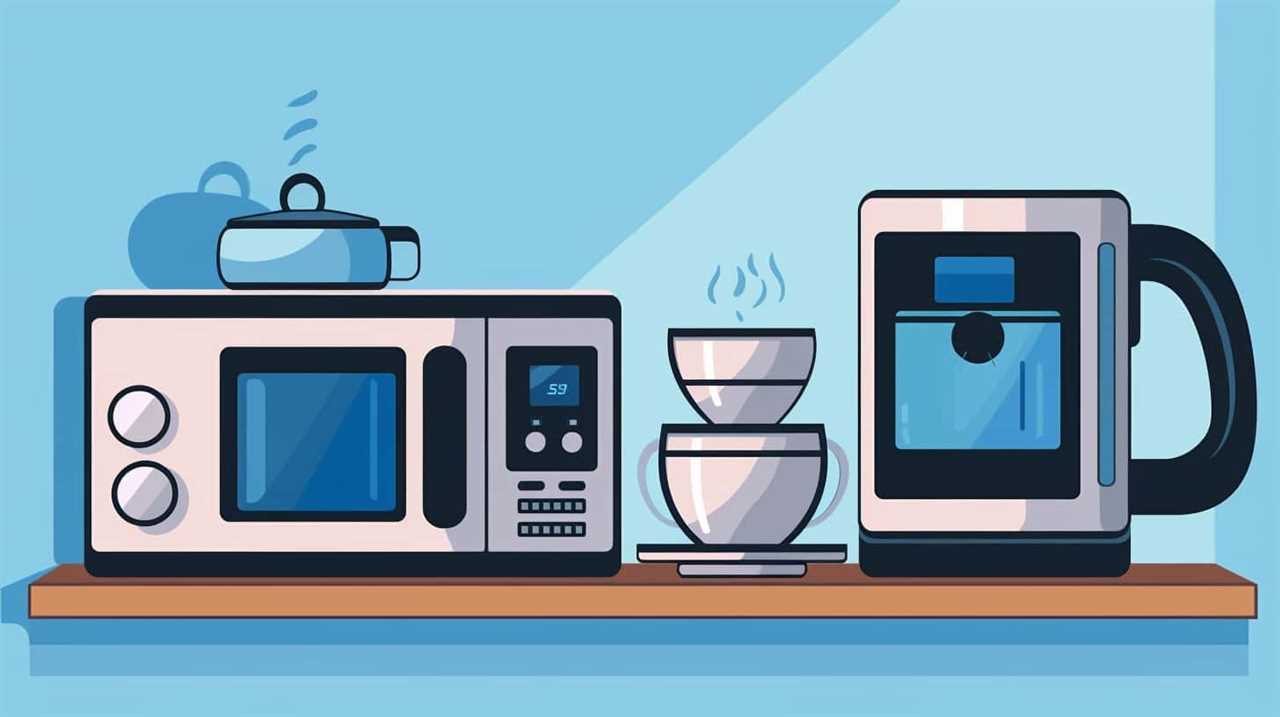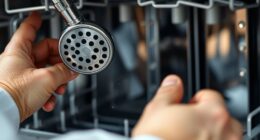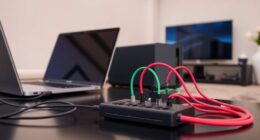Hey landlords, this message is for you!
Are you ready to ensure the utmost safety for your tenants? Look no further than our comprehensive guide to the top 15 essential appliance safety checks.
We understand the importance of maintaining a secure and hazard-free environment, which is why we’ve compiled a list of the most critical inspections for your appliances.
From examining electrical connections and gas lines to verifying proper functioning of timers and controls, our guide covers it all.

By following these safety checks, you can rest assured that your appliances are in peak condition, reducing the risk of accidents or malfunctions.
So let’s dive in and make sure your properties are equipped with the safest appliances around!
Key Takeaways
- Thoroughly inspect electrical panels and circuit breakers for loose or damaged connections, signs of overheating, and matching amperage.
- Regularly maintain and inspect gas and fuel lines to prevent potential gas leaks or hazards.
- Regularly clean and maintain ventilation systems to prevent health risks for tenants.
- Proper installation, cleaning, and maintenance of appliances are essential for safety.
Electrical Connections and Wiring
We’ll begin by conducting a thorough inspection of the electrical connections and wiring in the rental property. Ensuring electrical safety precautions and fire hazard prevention is of utmost importance for both landlords and tenants. Faulty electrical connections and wiring pose a significant risk of electrical shocks, fires, and property damage.
To mitigate these risks, we’ll first examine the electrical panels and circuit breakers. We’ll check for loose or damaged connections, signs of overheating, and ensure that the amperage of the breakers matches the wire capacity. Additionally, we’ll inspect outlets and switches for any visible damage or signs of wear and tear. Any faulty outlets or switches will be promptly replaced to prevent electrical hazards.

Furthermore, we’ll assess the condition of the wiring throughout the property. We’ll look for frayed or exposed wires, as well as any signs of improper installation. It’s crucial to identify and address any potential fire hazards caused by faulty wiring.
During our inspection, we’ll also pay close attention to the grounding system. Proper grounding is essential for electrical safety. We’ll ensure that all outlets and electrical appliances are grounded, reducing the risk of electrical shocks.
Gas and Fuel Line Inspections
When it comes to ensuring the safety of our tenants, regular maintenance and inspections of gas and fuel lines are essential. By regularly checking and maintaining these lines, we can prevent potential gas leaks or other hazards.
It’s crucial to hire professionals who are trained in gas line inspections to ensure the safety of everyone in the property.

Regular Maintenance for Safety
To ensure the safety of our tenants, we conduct regular gas and fuel line inspections. These inspections are crucial in identifying and addressing potential hazards that could pose a risk to the well-being of our residents.
Here are four key aspects of our maintenance schedule:
- Visual Inspection: We visually inspect the gas and fuel lines to check for any signs of damage, leaks, or corrosion that could compromise safety.
- Pressure Testing: We perform pressure tests to ensure that the lines can handle the required gas or fuel flow without any issues.
- Maintenance and Cleaning: We conduct regular maintenance and cleaning of the lines to prevent blockages and maintain optimal performance.
- Documentation: We keep detailed records of all inspections, repairs, and maintenance activities to ensure accountability and track any recurring issues.
Professional Inspections Ensure Safety
Professional inspections play a vital role in ensuring the safety of gas and fuel lines for landlords. These inspections are conducted by professionals who’ve undergone extensive professional training and are well-versed in safety protocols.
Gas and fuel lines can pose significant risks if not properly maintained and inspected. By having these lines regularly inspected by professionals, landlords can ensure that any potential issues or hazards are identified and addressed promptly.

Professional inspectors have the knowledge and expertise to thoroughly assess the condition of gas and fuel lines, check for leaks or damages, and ensure that all safety measures are in place. They follow strict safety protocols to minimize the risk of accidents or gas leaks, providing landlords with peace of mind and ensuring the safety of their properties and tenants.
Ventilation System Maintenance
Now let’s talk about the importance of regular cleaning and maintenance for ventilation systems.
As landlords, we must ensure that these systems are functioning properly to prevent potential health risks for our tenants.
Neglecting ventilation system maintenance can lead to a buildup of dust, allergens, and even mold, which can negatively impact indoor air quality and contribute to respiratory issues.

Importance of Regular Cleaning
As landlords, we understand the importance of regular cleaning and maintenance for the ventilation system to ensure the safety and well-being of our tenants. Here are four reasons why regular cleaning is crucial for maintaining a healthy living environment:
- Eliminating allergens: Over time, dust, pollen, and other allergens can accumulate in the ventilation system, leading to respiratory problems for tenants with allergies or asthma.
- Improving air quality: A clean ventilation system helps remove pollutants, odors, and contaminants from the air, promoting a healthier living space for tenants.
- Preventing mold growth: Moisture can build up in the ventilation system, creating an ideal environment for mold to thrive. Regular cleaning helps prevent mold growth, reducing potential health risks for tenants.
- Ensuring proper airflow: A clean ventilation system allows for better airflow, which helps regulate temperature and humidity levels, optimizing comfort and reducing the risk of respiratory issues.
Regular cleaning of the ventilation system is essential to maintaining a safe and healthy living environment for our tenants. Neglecting this maintenance can lead to potential health risks and discomfort for those living in our properties.
Potential Health Risks
One of the potential health risks associated with ventilation system maintenance is the accumulation of harmful pollutants in the air. Regular cleaning of the ventilation system is of utmost importance to mitigate these risks.
Over time, dust, dirt, and other particles can build up in the ventilation system, leading to poor indoor air quality. This can result in various health issues, such as allergies, respiratory problems, and even infections. Regular cleaning helps to remove these pollutants and ensure that the air circulating in the property is clean and safe for occupants.

Proper Installation of Appliances
When installing appliances, we prioritize proper installation to ensure safety for both tenants and the property. Here are four essential steps to follow for installation safety and appliance maintenance:
- Read the manufacturer’s instructions: Before starting the installation process, thoroughly read and understand the manufacturer’s instructions. This will ensure that you follow the correct installation procedures and avoid any potential safety hazards.
- Check for proper ventilation: Proper ventilation is crucial for appliances such as dryers, refrigerators, and stoves. Make sure that there’s adequate space around the appliance to allow for proper airflow. Blocked ventilation can lead to overheating, reduced efficiency, and even fire hazards.
- Securely fasten the appliance: Improperly secured appliances can pose a safety risk to tenants. Ensure that the appliance is securely fastened to prevent it from toppling over or causing any accidents.
- Verify electrical connections: Faulty electrical connections can lead to electrical shocks, fires, or damage to the appliance. Double-check that all electrical connections are properly installed and secure. If you’re unsure about electrical work, it’s best to hire a professional electrician.
By following these installation safety measures, you can protect your tenants and property from potential hazards.
Now let’s move on to the next section, which covers regular cleaning and maintenance to ensure the longevity and efficiency of your appliances.
Regular Cleaning and Maintenance
After ensuring proper installation of appliances, we now move on to the important task of regular cleaning and maintenance. Regular cleaning and maintenance are essential to ensure the safe and efficient operation of appliances in rental properties. Neglecting these tasks can lead to potential hazards and costly repairs. To prevent such issues, landlords should establish a cleaning and maintenance schedule and educate tenants on proper care.

Cleaning appliances regularly helps remove built-up dirt, dust, and debris, which can cause malfunctions and reduce efficiency. It’s important to use appropriate cleaning techniques for each appliance. For example, ovens should be cleaned regularly to prevent grease buildup and potential fire hazards. Refrigerators should be cleaned and defrosted periodically to maintain optimal performance and prevent the growth of mold and bacteria.
In addition to cleaning, regular maintenance is crucial to identify and address any potential hazards or malfunctions. Landlords should inspect appliances, such as washing machines and dryers, for loose connections, leaks, or unusual noises. They should also ensure that vents and filters are cleaned or replaced regularly to prevent blockages and improve air quality.
Checking for Gas Leaks and Carbon Monoxide
When it comes to ensuring the safety of our rental properties, checking for gas leaks and carbon monoxide is of utmost importance. Proper ventilation and airflow are essential to prevent the accumulation of harmful gases.
Regular maintenance and inspections should be carried out to detect any potential leaks or issues with gas appliances.

Additionally, educating tenants about the risks associated with gas leaks and carbon monoxide is crucial for their safety and well-being.
Ventilation and Airflow
As landlords, we prioritize the safety of our tenants by regularly checking for gas leaks and carbon monoxide, ensuring proper ventilation and airflow in the rental property. Here are four essential ventilation and airflow checks to maintain air quality control in your property:
- Inspect ventilation systems:
Regularly check the ventilation systems, including exhaust fans, air ducts, and vents, to ensure they’re clean and functioning properly. Blocked or damaged vents can restrict airflow and lead to poor air quality. - Test carbon monoxide detectors:
Carbon monoxide is a silent killer, so make sure to test and replace the batteries in carbon monoxide detectors regularly. This will help detect any leaks and protect your tenants from the harmful effects of this odorless gas. - Conduct air quality assessments:
Consider hiring a professional to conduct regular air quality assessments to identify any potential issues with ventilation and airflow. This will help you maintain a healthy living environment for your tenants. - Provide adequate ventilation:
Ensure that your rental property has proper ventilation in all areas, including kitchens, bathrooms, and laundry rooms. Good ventilation helps remove moisture, odors, and pollutants, improving indoor air quality.
Regular Maintenance and Inspections
To ensure the safety of our tenants, we actively conduct regular maintenance and inspections. These inspections are done to check for gas leaks and carbon monoxide. Regular maintenance benefits both the landlord and the tenants. It helps minimize the risk of accidents and ensures the proper functioning of appliances. Gas leaks can lead to fires or explosions, while carbon monoxide leaks can be deadly. By conducting regular inspections, we can detect any potential issues early on and take appropriate action to resolve them. This not only protects the tenants but also reduces the risk of property damage. We understand the importance of these inspections and prioritize the safety of our tenants above all else. By staying proactive and vigilant, we can provide a safe living environment for everyone.
Educating Tenants on Risks
We actively educate our tenants about the risks associated with gas leaks and carbon monoxide. It’s crucial for tenants to be aware of the potential dangers and how to prevent them. Here are four key points we cover when educating tenants on safety awareness and promoting safe appliance usage:

- Importance of regular inspections: We emphasize the importance of regular inspections to identify any potential gas leaks or carbon monoxide hazards. This includes checking gas lines, appliances, and ventilation systems.
- Signs of gas leaks and carbon monoxide: We educate tenants on the signs of gas leaks, such as the smell of gas or hissing sounds, and the symptoms of carbon monoxide poisoning, including headaches, dizziness, and nausea. It’s important for tenants to recognize these signs and take immediate action.
- Proper ventilation: We stress the need for proper ventilation in the property to minimize the risk of gas leaks and carbon monoxide buildup. Tenants are instructed to keep vents and flues clear and to never block or cover them.
- Emergency protocols: We provide tenants with clear instructions on what to do in case of a gas leak or carbon monoxide emergency. This includes evacuating the property, calling emergency services, and not re-entering until it’s safe to do so.
By educating our tenants on these risks and preventative measures, we empower them to prioritize their safety.
Now, let’s move on to the next section about testing and replacing faulty parts.
Testing and Replacing Faulty Parts
When testing and replacing faulty parts, it’s imperative for landlords to prioritize the safety of their tenants. Proper testing methods and troubleshooting techniques are essential to ensure that appliances are in good working condition and don’t pose any risks.
To begin, landlords should conduct regular inspections of appliances to identify any potential issues. This includes checking for loose connections, damaged cords, or signs of wear and tear. Additionally, testing the functionality of each appliance is crucial to detect any faulty parts that may need replacing.

When testing appliances, landlords should follow the manufacturer’s guidelines and recommendations. This may involve using specific tools or equipment to accurately assess the performance and safety of the appliance. It’s important to pay attention to any unusual sounds, smells, or vibrations that may indicate a problem.
If a faulty part is identified during testing, it should be promptly replaced. This may involve contacting a professional repair service or sourcing the necessary replacement part. It’s crucial to use genuine parts that are compatible with the appliance to ensure optimal performance and safety.
Ensuring Proper Grounding and Bonding
When it comes to electrical safety in our rental properties, ensuring proper grounding and bonding is crucial.
Proper grounding provides a safe path for electrical currents to flow, protecting both the appliances and the occupants from potential electrical hazards.

Additionally, proper bonding helps prevent electrical shocks and ensures that electrical systems function efficiently.
Grounding for Electrical Safety
To ensure proper grounding and bonding for electrical safety, it’s crucial to perform regular inspections and maintenance on appliances. Here are four important steps to follow:
- Familiarize yourself with electrical safety regulations: Stay updated on the latest electrical safety regulations to ensure compliance and protect your tenants.
- Use grounding techniques: Proper grounding is essential to prevent electrical shocks and fires. Install grounding systems according to industry standards to ensure a safe environment.
- Inspect outlets and wiring regularly: Check outlets for loose connections or signs of damage. Inspect wiring for frayed or exposed wires. Promptly repair or replace any faulty components.
- Hire a qualified electrician for inspections: Regular inspections by a qualified electrician can help identify potential hazards and ensure that your electrical system is safe and up to code.
By following these steps, you can maintain a safe electrical environment for your tenants.
Now, let’s discuss the importance of proper bonding.

Importance of Proper Bonding
Proper bonding is crucial for ensuring a safe and reliable electrical system for both landlords and tenants. It involves the correct grounding and bonding of electrical appliances to prevent electrical shocks and fires. Landlords must prioritize the proper grounding of appliances to create a secure environment for their tenants.
To ensure proper bonding, landlords should follow appliance certification guidelines provided by manufacturers. This guarantees that electrical appliances are installed correctly and in compliance with safety standards. Conducting regular inspections and maintenance checks will help identify any issues with grounding or bonding.
Here is a table outlining the importance of proper grounding and bonding:
| Importance of Proper Grounding and Bonding |
|---|
| Prevents electrical shocks and fires |
| Ensures the safety of tenants |
| Reduces the risk of electrical accidents |
Verifying Appliance Certifications and Standards
How can we ensure that appliance certifications and standards are being properly verified? Here are four essential steps to take:

- Verify appliance warranties: It’s crucial to confirm that all appliances come with valid warranties. Check the manufacturer’s documentation or contact the company directly to ensure that the warranty is in place and covers the necessary repairs or replacements.
- Conduct appliance recalls: Stay updated on appliance recalls and take immediate action if any of the appliances in your property are affected. Regularly check the manufacturer’s website, consumer protection agencies, and government recall databases to ensure that you’re aware of any potential safety issues with the appliances.
- Check for certification labels: Look for certification labels on the appliances, such as UL (Underwriters Laboratories) or CSA (Canadian Standards Association). These labels indicate that the appliances have undergone rigorous testing and meet safety standards. Make sure the labels are present and visible on each appliance.
- Consult professional inspectors: Consider hiring professional inspectors to verify the certifications and standards of your appliances. These experts have the knowledge and experience to properly assess the safety and compliance of the appliances, giving you peace of mind.
By following these steps, you can ensure that the appliances in your property meet the necessary certifications and standards, minimizing the risk of accidents or malfunctions.
Now let’s move on to the next section, where we’ll discuss the importance of checking for overheating or excessive noise.
Checking for Overheating or Excessive Noise
We regularly check our appliances for signs of overheating or excessive noise to ensure their safety and functionality. Overheating can lead to serious safety hazards, such as fires or electrical malfunctions. To prevent overheating, we make sure that our appliances aren’t blocked by any objects or debris that could obstruct proper airflow. We also clean the vents and filters regularly to prevent dust buildup. Additionally, we inspect the power cords and plugs for any signs of wear or damage that could potentially cause overheating.
Excessive noise from appliances can be disruptive and indicate underlying issues. To reduce noise levels, we employ various noise reduction techniques. These include placing rubber or felt pads under appliances to absorb vibrations, tightening loose screws or parts that may be causing the noise, and ensuring that appliances are placed on level surfaces to minimize rattling or shaking.

By regularly checking for overheating and excessive noise, we prioritize the safety and functionality of our appliances.
Moving forward, we’ll now discuss the importance of inspecting safety features and controls to further enhance appliance safety measures.
Inspecting Safety Features and Controls
To ensure the safety and functionality of our appliances, we regularly inspect the safety features and controls. Here are the key aspects we focus on when inspecting safety controls:
- Testing the emergency shut-off feature: We make sure that the emergency shut-off feature is working correctly. This is crucial in case of any emergencies or malfunctions that require immediate action.
- Verifying the proper operation of safety sensors: We inspect the safety sensors to ensure they’re functioning as intended. These sensors play a vital role in detecting any potential hazards and shutting off the appliance if necessary.
- Checking the condition of safety valves and switches: We examine the condition of safety valves and switches to ensure they’re in good working order. These components are designed to prevent accidents or damage by automatically shutting off the appliance in certain situations.
- Inspecting control knobs and buttons: We carefully inspect control knobs and buttons to ensure they’re functioning properly. This includes checking for any loose or damaged parts that may affect the appliance’s performance or pose a safety risk.
By regularly inspecting these safety controls, we can ensure the proper functioning of our appliances and minimize any potential safety hazards.

Now, let’s move on to the next section where we’ll discuss assessing appliance placement and clearances.
Assessing Appliance Placement and Clearances
When evaluating appliance placement and clearances, we assess the optimal positioning and distance required for safe operation. It’s crucial to consider the maintenance and safety measures when determining the placement of appliances in rental properties. A thorough assessment of appliance placement ensures that they aren’t obstructed or causing any potential hazards.
Firstly, we evaluate the proximity of appliances to combustible materials. It’s essential to maintain a safe distance between appliances and flammable objects such as curtains, paper, or cleaning supplies. This helps prevent any fire hazards that may arise from heat generated by the appliances.
Secondly, we assess the clearance around appliances. Sufficient space is necessary to allow proper ventilation and prevent overheating. Appliances like refrigerators and dryers require adequate airflow to function efficiently and minimize the risk of malfunctions or breakdowns.

Additionally, we consider the accessibility of appliances for maintenance and repairs. Appliances should be positioned in a way that allows easy access for any necessary upkeep or repairs. This ensures that landlords can address maintenance issues promptly, minimizing any inconvenience or risks for tenants.
Examining Appliance Cords and Plugs
As landlords, we carefully examine appliance cords and plugs to ensure their safety and functionality. This is an essential step in maintaining a safe and reliable rental property. Here are four key aspects to consider when examining appliance cords and plug safety:
- Visual inspection: We start by visually inspecting the cords and plugs for any visible signs of damage, such as fraying, cracking, or exposed wires. Any signs of wear and tear indicate that the cord may be compromised and in need of repair or replacement.
- Proper grounding: We ensure that all appliances are properly grounded to prevent electrical shocks. We check if the plugs have three prongs and that the grounding prong is intact. If a plug is missing the grounding prong or if it’s damaged, we replace it immediately.
- Adequate cord length: We make sure that the appliance cords have sufficient length to reach the nearest outlet without being stretched or strained. Stretching cords can lead to damage or overheating, so we avoid using extension cords whenever possible.
- Secure connections: We verify that the plugs are securely inserted into the outlets and that they fit snugly. Loose connections can cause sparks, overheating, or even electrical fires, so we ensure that all plugs are firmly in place.
Examining appliance cords and plugs is just one step towards ensuring the safety of our rental properties. Now, let’s move on to the next crucial task: verifying the proper functioning of timers and controls.
Verifying Proper Functioning of Timers and Controls
Now, we verify that timers and controls are functioning properly to ensure the safe and efficient operation of our appliances. It’s crucial to regularly check the functionality of these components as they play a vital role in maintaining the safety controls of our appliances.

Timers allow for programmed operation, ensuring appliances are turned off when not in use, preventing potential hazards such as overheating or electrical fires. Controls, on the other hand, regulate various settings, such as temperature or pressure, providing a safe and controlled environment for appliance operation.
To verify the functionality of timers and controls, start by inspecting the display panels for any signs of damage or malfunction. Check if the buttons or knobs are responsive and if they accurately adjust the settings. Test the timers by setting them to different durations and observing if the appliances turn on and off as intended. Additionally, verify that the safety controls, such as temperature limiters or pressure sensors, are operating correctly by conducting a thorough examination as outlined by the manufacturer’s guidelines.
Testing Emergency Shut-Off Mechanisms
How do we test the emergency shut-off mechanisms to ensure the safety of our appliances?
Here are four steps to follow when testing the emergency shut-off mechanisms:

- Locate the shut-off switch: Familiarize yourself with the location of the emergency shut-off switch for each appliance. It’s usually located near the appliance or in a nearby utility room.
- Test the shut-off switch: Turn on the appliance and then activate the emergency shut-off switch. Observe if the appliance immediately shuts off. If it doesn’t, there may be a malfunction with the shut-off mechanism that needs to be addressed.
- Check for proper reset: After activating the emergency shut-off switch, reset it and turn the appliance back on. Ensure that the appliance starts up and operates normally.
- Troubleshoot appliance malfunctions: If the emergency shut-off mechanism doesn’t work as expected, consult the appliance’s manual or contact a qualified technician for further troubleshooting and repairs.
Regularly testing the emergency shut-off mechanisms is crucial for maintaining the safety of your appliances and preventing potential accidents.
Frequently Asked Questions
How Often Should Appliance Cords and Plugs Be Examined?
Appliance cords and plugs should be examined regularly to ensure their safety and functionality. Maintenance is important in preventing electrical hazards and prolonging the lifespan of appliances.
Regular inspections help identify any signs of wear, fraying, or damage to the cords and plugs, allowing for timely repairs or replacements. By conducting these examinations frequently, landlords can prioritize the safety of their tenants and avoid potential accidents or electrical malfunctions.
What Should Landlords Do if They Suspect a Gas Leak or Carbon Monoxide Issue?
When it comes to gas leak detection and carbon monoxide issues, landlords need to take immediate action.

If there’s a suspicion of a gas leak, it’s crucial to evacuate the premises and contact the gas company or emergency services.
To prevent carbon monoxide poisoning, landlords should install carbon monoxide detectors in every unit and test them regularly.
These safety measures are essential to protect the well-being and lives of tenants.
Are There Any Specific Certifications or Standards That Landlords Should Look for When Verifying Appliance Safety?
When it comes to appliance safety, it’s crucial for landlords to be aware of the specific certifications and standards to look for during the verification process. These certifications ensure that the appliances meet safety requirements and are in good working condition.

By checking for these certifications, landlords can have peace of mind knowing that their tenants are protected from potential hazards.
It’s important to prioritize safety and adhere to these standards to maintain a high level of professionalism and responsibility as a landlord.
How Frequently Should Emergency Shut-Off Mechanisms Be Tested?
Regular inspections of emergency shut-off mechanisms are essential for ensuring the safety of our appliances. Testing the shut-off mechanisms frequently is crucial for identifying any potential malfunctions or issues that could lead to emergencies. By conducting these tests on a regular basis, we can address any problems promptly and prevent major accidents.
It’s our responsibility as landlords to prioritize the safety of our tenants, and regular inspections play a vital role in achieving this goal.

What Steps Can Landlords Take to Ensure Proper Grounding and Bonding of Appliances?
To ensure proper grounding and bonding of appliances, we recommend conducting regular inspections. These essential safety checks help landlords maintain a safe environment for tenants.
By verifying that appliances are correctly grounded and bonded, we can prevent electrical hazards and potential accidents. Our thorough inspections guarantee that all appliances meet safety standards, giving landlords peace of mind and ensuring the well-being of their tenants.
Don’t underestimate the importance of these inspections in maintaining a secure and reliable rental property.
Conclusion
So there you have it, folks! After going through the top 15 essential appliance safety checks for landlords, we can all rest easy knowing that our tenants are in good hands.

With proper electrical connections, gas line inspections, and regular maintenance, our appliances will be as safe as a kitten in a bubble wrap suit.
Remember, a well-maintained appliance is a happy appliance. Happy landlords make for happy tenants.
Cheers to appliance safety, and may your rental properties be forever accident-free!
